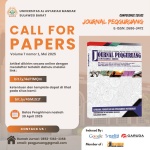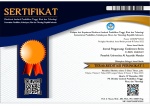Tafsir Kepribadian di TikTok: Analisis Tindak Tutur Komentator pada konten Motivasi dengan Big Five (OCEAN)
Abstract
Keywords
Full Text:
PDFReferences
Altuwairiqi, M., Jiang, N., & Ali, R. (2019). Problematic Attachment to Social Media: Five Behavioural Archetypes. International Journal of Environmental Research and Public Health, 16(12), 2136. https://doi.org/10.3390/ijerph16122136
Arief, E., Tressyalina, T., & Noveria, M. (2021). Teacher’s Expressive Speech Acts in Learning Bahasa Indonesia Class XI at SMA 1 Luhak Nan Duo. Advances in Social Science, Education and Humanities Research/Advances in Social Science, Education and Humanities Research. https://doi.org/10.2991/assehr.k.211201.016
Azizah, R. N., & Suhardi, S. (2020). Directive and Commissive Speech Acts in “Kartini” Movie. https://doi.org/10.2991/assehr.k.200804.050
Cai, L., & Liu, X. (2022). Identifying Big Five personality traits based on facial behavior analysis. Frontiers in Public Health, 10. https://doi.org/10.3389/fpubh.2022.1001828
Camps, J., Stouten, J., & Euwema, M. (2016). The Relation Between Supervisors’ Big Five Personality Traits and Employees’ Experiences of Abusive Supervision. Frontiers in Psychology, 7, 112. https://doi.org/10.3389/fpsyg.2016.00112
Cheng, Z., & Li, Y. (2023). Like, Comment, and Share on TikTok: Exploring the Effect of Sentiment and Second-Person View on the User Engagement with TikTok News Videos. Social Science Computer Review, 42(1), 201. https://doi.org/10.1177/08944393231178603
Compte, D. L., & Klug, D. (2021). “It’s Viral!” -- A study of the behaviors, practices, and motivations of TikTok Social Activists. arXiv (Cornell University). https://doi.org/10.48550/arXiv.2106.08813
Compte, D. L., & Klug, D. (2021). “It’s Viral!” -- A study of the behaviors, practices, and motivations of TikTok Social Activists. arXiv (Cornell University). https://doi.org/10.48550/arXiv.2106.08813
Cuesta‐Valiño, P., Gutiérrez‐Rodríguez, P., & Durán‐Álamo, P. (2022). Why Do People Return to Video Platforms? Millennials and Centennials on TikTok. Media and Communication, 10(1), 198–207. https://doi.org/10.17645/mac.v10i1.4737
Dayong, Z., & Su, Z. (2022). Short video users’ personality traits and social sharing motivation. Frontiers in Psychology, 13. https://doi.org/10.3389/fpsyg.2022.1046735
Eisenberg, N., Duckworth, A., Spinrad, T. L., & Valiente, C. (2012). Conscientiousness: Origins in childhood? [Review of Conscientiousness: Origins in childhood?]. Developmental Psychology, 50(5), 1331. American Psychological Association. https://doi.org/10.1037/a0030977
Graziano, W. G., & Eisenberg, N. (1997). Agreeableness. In Elsevier eBooks (p. 795). Elsevier BV. https://doi.org/10.1016/b978-012134645-4/50031-7
Gu, L., Gao, X., & Li, Y. (2022). What drives me to use TikTok: A latent profile analysis of users’ motives. Frontiers in Psychology, 13, 992824. https://doi.org/10.3389/fpsyg.2022.992824
Literat, I., & Kligler-Vilenchik, N. (2023). TikTok as a Key Platform for Youth Political Expression: Reflecting on the Opportunities and Stakes Involved. Social Media + Society, January–March 2023, 1–3. https://doi.org/10.1177/20563051231157595
McAdams, D. P., & Pals, J. L. (2006). A New Big Five: Fundamental Principles for an Integrative Science of Personality. American Psychologist, 61(3), 204–217. https://doi.org/10.1037/0003-066X.61.3.204
McCabe, K. O., & Fleeson, W. (2012). What Is Extraversion For? Integrating Trait and Motivational Perspectives and Identifying the Purpose of Extraversion. Psychological Science, 23(12), 1498. https://doi.org/10.1177/0956797612444904
Reizer, A., Harel, T., & Ben‐Shalom, U. (2023). Helping Others Results in Helping Yourself: How Well-Being Is Shaped by Agreeableness and Perceived Team Cohesion. Behavioral Sciences, 13(2), 150. https://doi.org/10.3390/bs13020150
Rhoades, L., & Eisenberger, R. (2002). Perceived organizational support: A review of the literature. [Review of Perceived organizational support: A review of the literature.]. Journal of Applied Psychology, 87(4), 698. American Psychological Association. https://doi.org/10.1037/0021-9010.87.4.698
Roberts, B. W., Bogg, T., Walton, K. E., Chernyshenko, O. S., & Stark, S. (2003). A lexical investigation of the lower-order structure of conscientiousness. Journal of Research in Personality, 38(2), 164. https://doi.org/10.1016/s0092-6566(03)00065-5
Sangwan, N. (2023). Exploring the Big Five Theory: Unveiling the Dynamics and Dimensions of Personality. Sports Science & Health Advances, 1(2), 73–77. https://doi.org/10.60081/SSHA.1.2.2023.73-77
Us’ariasih, J., Febiola, T., Herlina, A. R. P., Mahardika, R. N., Mumtaz, N. A., Utomo, A. P. Y., & Yanitama, A. (2024). Analisis Tindak Tutur Ekspresif dan Direktif pada Video Edukasi Bertema Sains dalam Kanal YouTube “Kok Bisa?” Fonologi: Jurnal Ilmuan Bahasa dan Sastra Inggris, 2(1), 41–64. https://doi.org/10.61132/fonologi.v2i1.308
Xia, J., He, Q., Li, Y., Xie, D., Zhu, S., Chen, J., Shen, Y., Zhang, N., Wei, Y., Chen, H.-C., Shen, J., Zhang, Y., Gao, C., Li, Y., Ding, J., Shen, W., Wang, Q., Cao, M., Liu, T., … Wang, X. (2011). The relationship between neuroticism, major depressive disorder and comorbid disorders in Chinese women. Journal of Affective Disorders, 135, 100. https://doi.org/10.1016/j.jad.2011.06.053
Zhang, D., & Su, Z. (2022). Short video users’ personality traits and social sharing motivation. Frontiers in Psychology, 13, 1046735. https://doi.org/10.3389/fpsyg.2022.1046735
Zheng, F. (2022). Research on User Interaction in TikTok. BCP Social Sciences & Humanities, 20, 202–204. DOI: https://doi.org/10.54691/bcpssh.v20i.2197
 DOI: http://dx.doi.org/10.35329/jp.v7i1.6114
DOI: http://dx.doi.org/10.35329/jp.v7i1.6114
Article Metrics
 Abstract views : 296 times |
Abstract views : 296 times |  PDF - 72 times
PDF - 72 times
Refbacks
- There are currently no refbacks.
Alamat Penyunting & Distribusi:
JOURNAL PEQGURUANG: Conference Series
E-ISSN: 2686-3472
Gedung Biro AKSI. Lt 2. Ruang Lembaga Penelitian dan Pengabdian Masyarakat Universitas Al Asyariah Mandar
Telp./Fax (0428) 21038
Email: peqguruang@gmail.com
Website: https://journal.lppm-unasman.ac.id/index.php/peqguruan/index
Penerbit:
Lembaga Penelitian dan Pengabdian Masyarakat Universitas Al Asyariah Mandar
Indexed by:
Member of:

JOURNAL PEQGURUANG: Conference Series is licensed under a Creative Commons Attribution-ShareAlike 4.0 International License.










